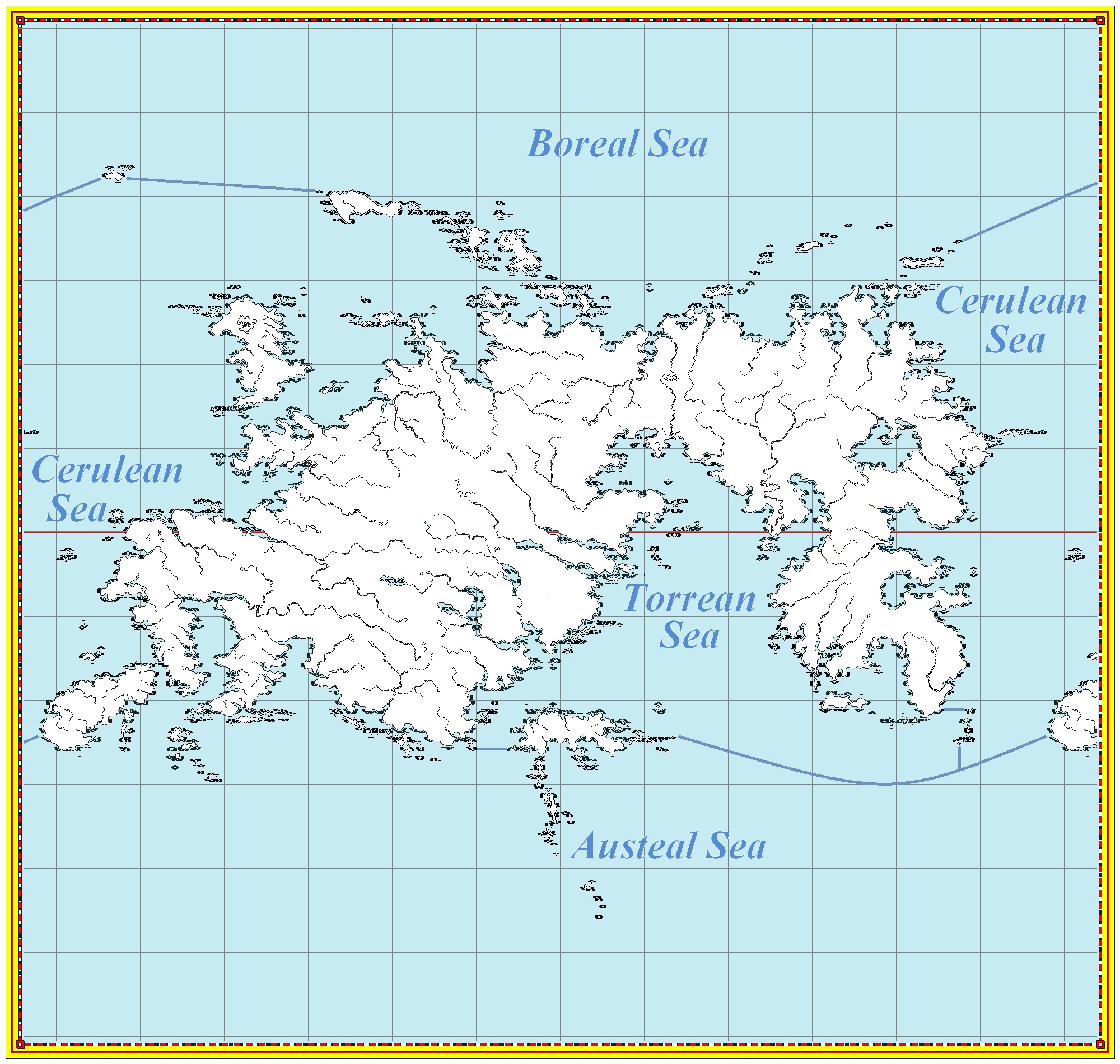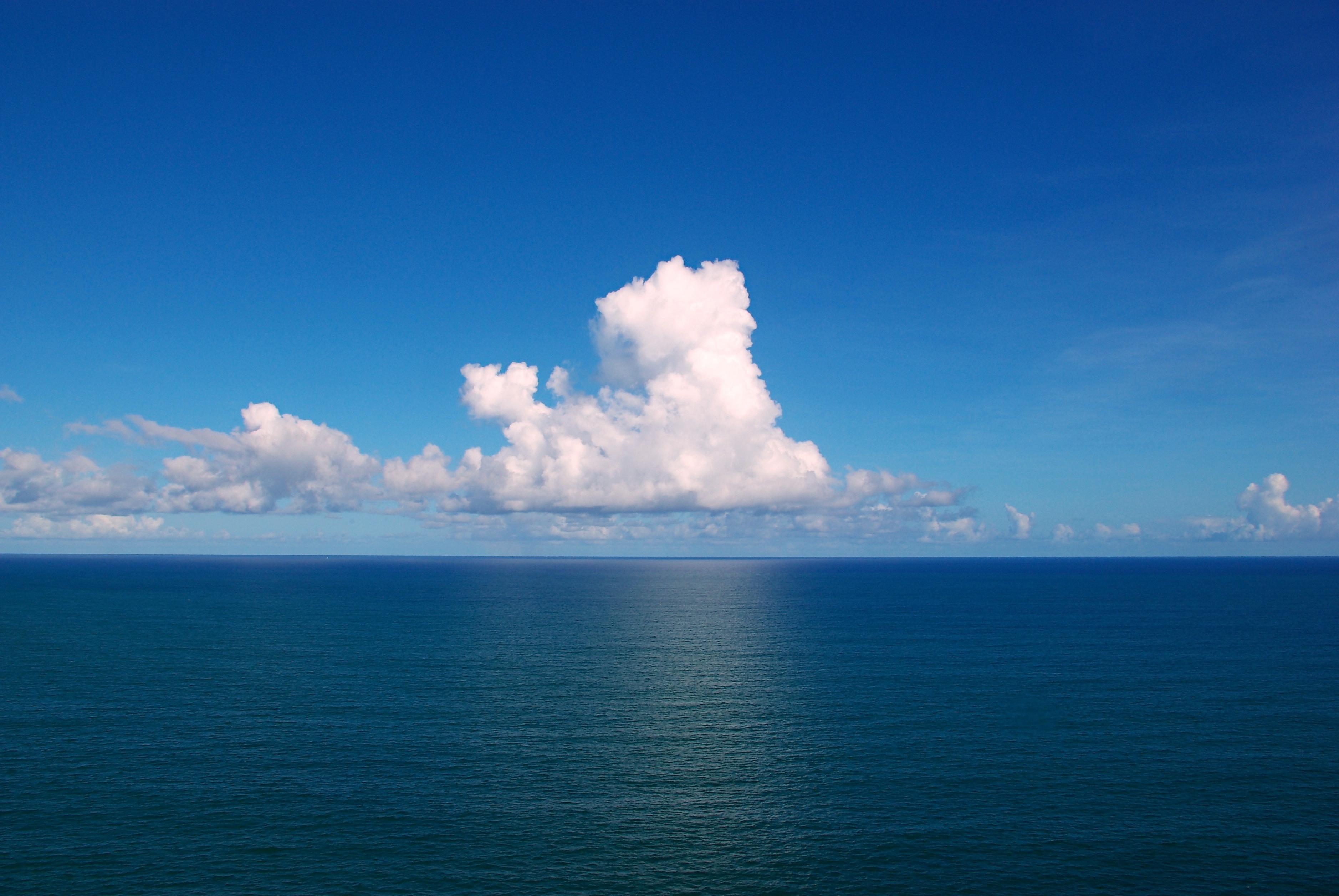The Ocean
The ocean (/ˈoʊ.ʃən/), sometimes called the world ocean or the global ocean, is the enormous basin of seawater that covers roughly 62% of the world’s surface and contains over 95% of the water on the planet. The ocean has traditionally been divided into four distinct regions called the high seas. They are known as the Austeal Sea (the largest), the Boreal Sea, the Cerulean Sea and the Torrean Sea (the smallest).
The four high seas are generally delineated by the shorelines of the continents and islands they touch, as well as other less distinct open water boundaries that have been accepted by common custom. Together they cover a combined 63,531,729 wmi2 of the world’s surface. The total volume of the world ocean is 119,813,839 wmi3.
The average depth of the ocean is 4,720 yds. (1.94 wmi.). The Torrean Sea is the shallowest of the four high seas, with an average depth of only 2,940 yds. However it also holds the distinction of being home to the ocean's deepest point, the Gan Bun Deep, which plunges a staggering 11,929 yds. below the surface to the bottom of the Central Torrean Trench. Overall though, the Austeal Sea is considered the world’s deepest ocean, with an average depth of 5,560 yds.
As the principal component of the world’s hydrosphere, the ocean is indispensable to life on the planet. It has a major influence upon weather and the climate, as well as the carbón and hydrologic cycles. The waters of the ocean contain dissolved gasses in large quantities, including ocsagin, carbón daocside, and nítrigin. Ocean photosynthesis creates 50% of all atmospheric ocsagin.
Seawater circulates continuously in the ocean, creating currents which move enormous amounts of water and heat around the globe. Regular ocean tides are caused by the gravitational pull of the Mhuna combined with the rotation of the planet. The surface of the ocean is constantly traversed by ridges or swells known as waves, which can vary greatly in their regularity, frequency and amplitude.
In spite of its large size and tremendous impact upon the very existence of every living organism on the planet, the ocean remains largely a mystery. More than 90% of the ocean has not been mapped or explored. Astronomers know more about the faces of the Mhuna than oceanographers know about the ocean floor. Nevertheless, many amazing discoveries have been made. It is known, for instance, that the ocean floor contains many towering mountain ranges, some even taller than those on land, as well as deep trenches similar to canyons on land.
Scientists believe life evolved in the ocean millions of years prior to its emergence on land. The ocean is home to over 235,000 known plant and animal species, with as much as 90% of the total number remaining undiscovered. Marine species range in size from microscopic planctón to the huge gorm whale - the largest known animal, which reaches up to 36 yds. in length.
The ocean has been an integral component of many human activities throughout history, including exploration, transportation, trade, naval warfare and food production. Much of the world's commerce takes place across the high seas, especially the Cerulean Sea and the Torrean Sea. Many important commodities are moved by ships traveling between the world's seaports. The ocean is also the primary source of supply stock for the fishing industry, which annually harvests large quantities of fish, shrimp, crabs and lobster. The largest annual global fishery harvests include cod, maikrel, sairdín and tuina.
The concept of "Freedom of the High Seas," which assures unrestrained navigation in international waters and prohibits naval warfare on the open ocean, has been a core principle of international maritime law since the mid-seventeenth century. It remains relevant today as a fundamental provision of the Council of Nations Convention on the Law of the High Seas.
Most marginal seas are located over a continental shelf. Despite being shallower, they are very similar to the open ocean - they are formed by analogous geologic processes, foster equivalent degrees of biodiversity and exhibit comparable layered circulation patterns. The primary differences between marginal seas and the open ocean are related to depth and proximity to land.
The four high seas are generally delineated by the shorelines of the continents and islands they touch, as well as other less distinct open water boundaries that have been accepted by common custom. Together they cover a combined 63,531,729 wmi2 of the world’s surface. The total volume of the world ocean is 119,813,839 wmi3.
The average depth of the ocean is 4,720 yds. (1.94 wmi.). The Torrean Sea is the shallowest of the four high seas, with an average depth of only 2,940 yds. However it also holds the distinction of being home to the ocean's deepest point, the Gan Bun Deep, which plunges a staggering 11,929 yds. below the surface to the bottom of the Central Torrean Trench. Overall though, the Austeal Sea is considered the world’s deepest ocean, with an average depth of 5,560 yds.
As the principal component of the world’s hydrosphere, the ocean is indispensable to life on the planet. It has a major influence upon weather and the climate, as well as the carbón and hydrologic cycles. The waters of the ocean contain dissolved gasses in large quantities, including ocsagin, carbón daocside, and nítrigin. Ocean photosynthesis creates 50% of all atmospheric ocsagin.
Seawater circulates continuously in the ocean, creating currents which move enormous amounts of water and heat around the globe. Regular ocean tides are caused by the gravitational pull of the Mhuna combined with the rotation of the planet. The surface of the ocean is constantly traversed by ridges or swells known as waves, which can vary greatly in their regularity, frequency and amplitude.
In spite of its large size and tremendous impact upon the very existence of every living organism on the planet, the ocean remains largely a mystery. More than 90% of the ocean has not been mapped or explored. Astronomers know more about the faces of the Mhuna than oceanographers know about the ocean floor. Nevertheless, many amazing discoveries have been made. It is known, for instance, that the ocean floor contains many towering mountain ranges, some even taller than those on land, as well as deep trenches similar to canyons on land.
Scientists believe life evolved in the ocean millions of years prior to its emergence on land. The ocean is home to over 235,000 known plant and animal species, with as much as 90% of the total number remaining undiscovered. Marine species range in size from microscopic planctón to the huge gorm whale - the largest known animal, which reaches up to 36 yds. in length.
The ocean has been an integral component of many human activities throughout history, including exploration, transportation, trade, naval warfare and food production. Much of the world's commerce takes place across the high seas, especially the Cerulean Sea and the Torrean Sea. Many important commodities are moved by ships traveling between the world's seaports. The ocean is also the primary source of supply stock for the fishing industry, which annually harvests large quantities of fish, shrimp, crabs and lobster. The largest annual global fishery harvests include cod, maikrel, sairdín and tuina.
The concept of "Freedom of the High Seas," which assures unrestrained navigation in international waters and prohibits naval warfare on the open ocean, has been a core principle of international maritime law since the mid-seventeenth century. It remains relevant today as a fundamental provision of the Council of Nations Convention on the Law of the High Seas.
Marginal Seas
Contained within the four high seas are numerous named bodies of water known as "marginal seas." A marginal sea is an area of the ocean adjacent to a continent, partially separated from the open high seas by a protrusion of land, island chain or submarine ridge on the sea floor. Larger marginal seas include the Velandrian Sea, the Gulf of Barchu, the Nemedian Sea, the Gulf of Kileshandra and Págánah Bay.Most marginal seas are located over a continental shelf. Despite being shallower, they are very similar to the open ocean - they are formed by analogous geologic processes, foster equivalent degrees of biodiversity and exhibit comparable layered circulation patterns. The primary differences between marginal seas and the open ocean are related to depth and proximity to land.




Pretty sure the ocean is a load of nonexistent nonsense made up by Hungary to sell pool toys but okay.